Evolution of airframes, aircraft, spacecraft and air power.
Don't wanna be here? Send us removal request.
Text

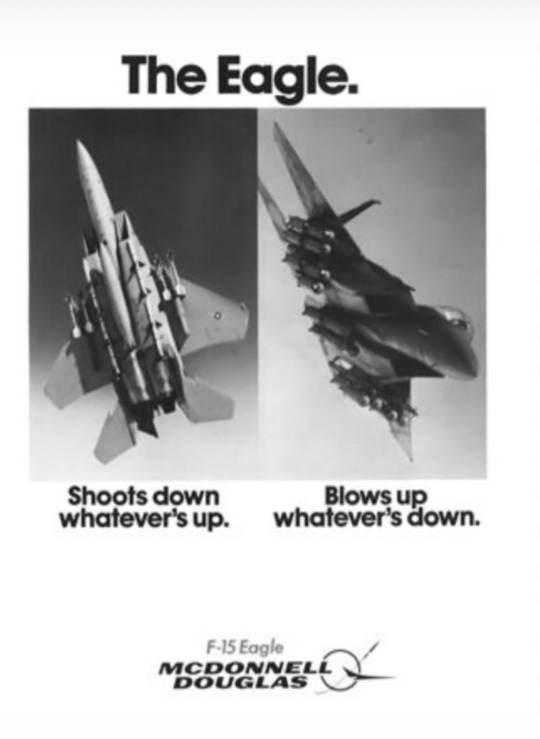

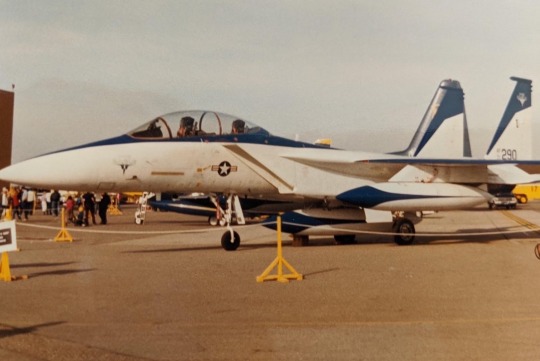


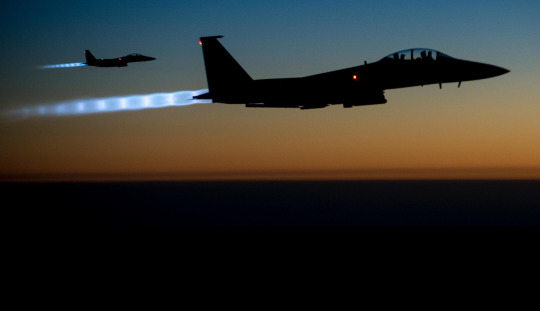


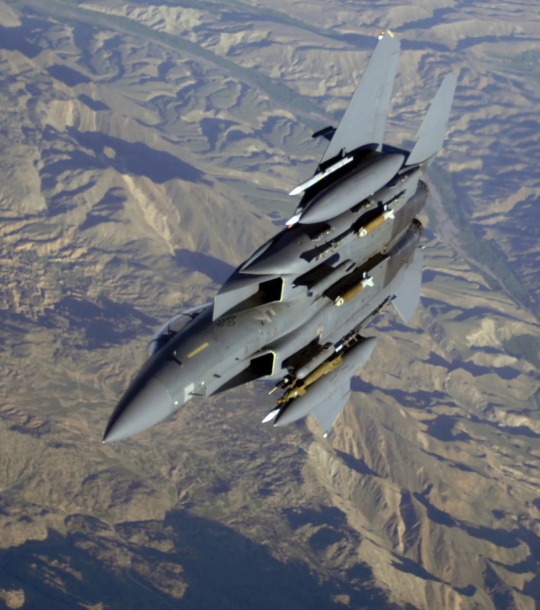
This year marks the 50th anniversary since McDonnell Douglas rolled out its iconic first generation of the F-15 eagle. The F-15 was created out of a need to counter the significant threat posed by the USSR’s own extremely capable air superiority fighter, the MiG-25 Foxbat, which could travel at speeds of just over Mach 3.
Since her rollout, the F-15 and her descendants have proved themselves extremely worthy of the title of air superiority fighter, retaining a kill to death ratio of over 104 kills and 0 losses in air to air combat, seeing service in Iraq and Afghanistan, along with the Japanese and Saudi air forces.
The newest generation of Eagle, the Boeing F-15EX, made is debut flight this year and is due to enter service with the United States Air Force in the near future, replacing the older “C” model of the F-15.
#f15eagle#history#historyinpictures#history pictures#military history#airpower#aviation#aviation history#usaf#us air force
90 notes
·
View notes
Text

Temple of Baal, Palymra, Syria, Unknown Date, Before Them.
16 notes
·
View notes
Text
Zebras on the plains, Unknown Location, Africa, 1920s
2 notes
·
View notes
Text

Australia, 1870
2 notes
·
View notes
Text

Waterloo Station Entrance, 2021
#history#military history#history pictures#historyinpictures#alt history#wwii#naval history#american history#flags#british empire#waterloo#architecture#neoclassical#britannia twitter
0 notes
Text
Today, 20 years ago, the world was shaken.
Society woke up to news that the strongest, most influential country of their time was compromised. That the nature of war had changed, that the nature of everything had changed. They woke up expecting a normal day in the American dream. Instead they got the American nightmare.
A nation compromised. A new way of life.
Never forget🇺🇸
1 note
·
View note
Text

Anti-war poster made in 2001 after 9/11 to oppose war in Iraq.
#history#military history#history pictures#historyinpictures#alt history#naval history#wwii#aviation history#flags#aviation#poster
1 note
·
View note
Text

IJN Yamato undergoing full speed trials, date and location classified.
0 notes
Text

-A Junkers Ju 188 (serial number 10001) parked on an airfield in 1942. | Photo: German Federal Archives
FLIGHTLINE: 188 - JUNKERS JU 188
Developed from the Ju 88, the 188 was produced in too few numbers to affect the outcome of WWII.
As Nazi Germany began its semi-clandestine rearmament campaign in the 1930s, the Luftwaffe developed the Schnellbomber doctrine, calling for bombers that traded defensive guns for speed. Junkers Flugzeug- und Motorenwerke AG ("Junkers Aircraft and Motor Works") responded with their Ju 88 twin engine design, which served throughout WWII as a schnellbomber, dive bomber, torpedo bomber, night fighter and heavy fighter, with more than 15,000 examples produced.

-A Ju 88 of 2nd Squadron, Bomber Wing 28, in flight. | Photo: German Federal Archives
In July of 1939 the Reichsluftfahrtministerium (RLM, "Ministry of Aviation") issued specifications for the 'Bomber B', which would fly faster and higher than the Ju 88 while carrying a higher bomb load. A maximum speed of 600kmh was called for, along with a bomb load of 4,000kg and the range needed to reach any part of England from bases in France or Norway. The specification also called for a pressurized cockpit and remotely controlled defensive turrets. Junkers submitted their Ju 288 design, which was derived from the Ju 88, which would be powered by the Junkers Jumo 222 multi-bank engine. Issues with the engine and landing gear delayed the 288 however, and Junkers proposed a modified Ju 88 as a stop-gap aircraft until the problems were ironed out.
DESIGN & VARIANTS
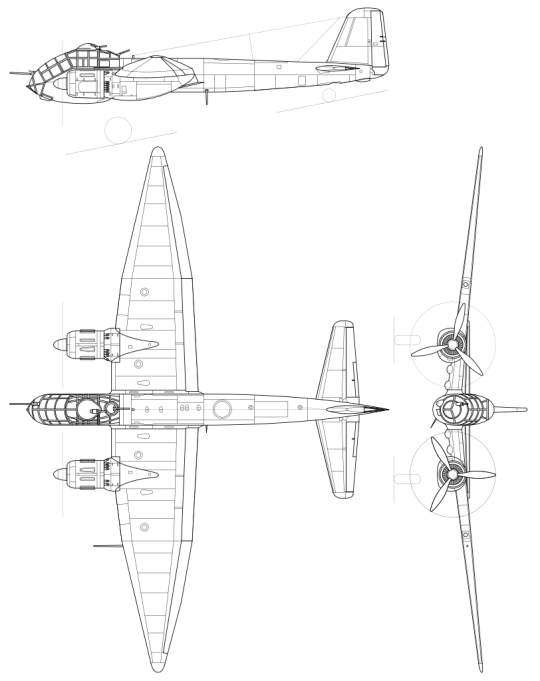
-Orthograph of the Ju 188 | Illustration: Kaboldy
What became the Ju 188 was first proposed as the Ju 88B, a variant rejected for being both too radical and unimpressive. The Ju 88B would have altered the original stepped cockpit, replacing it with an egg-shaped design composed of 36 curved panes in a greenhouse frame, which was smoothly fared into the ventral Bola defensive unit. This new nose and cockpit reduced the drag of the Ju 88B, making it marginally faster than other variants while at the same time improving crew visibility. The RLM considered the Ju 88B's gains were outweighed by the difficulty in production, and declined to procure the aircraft. When the Jumo 222 ran into trouble, delaying the Ju 288 and Fw 191 'Bomber B' programs, and with existing schnellbombers falling to improved RAF, USAAF and VVF fighter designs, Junkers resubmitted the Ju 88B, now designated the Ju 188.
The 188 was based on the Ju 88 A-1, adding in the 88B's cockpit design. The squared-off wingtips were now longer and pointed, which also reduced drag and improved performance. Junkers intended powerplant was their Jumo 213, which had reached the bench-test phase and was expected to develop 1,100kW (1,500hp), but the RLM stipulated that the design accept the BMW 801 engine in a Kraftei ("power-egg") unitized installation. The Kraftei, used on other twin- and multi-engine German aircraft, consisted of either a radial or inline piston engine, complete with all of the ancillary equipment, typically already enclosed in a cowling and equipped with quick-change attachment points and connectors for electrical, coolant and fuel lines. This allowed crews to swiftly remove and replace engines for maintenance as well as simplifying construction.
Two prototype Ju 188s were converted from existing Ju 88s, one Ju 88 E-O was modified with the projected defensive fit, two 13mm MG 131 and two 7.92mm MG 81Z in the Bola gondola, and the second, modified from a Ju 88 A-4, was designated the Ju 188 V1 and featured the larger tail fin that would be standard on later model Ju 88s and the Ju 188. A second V1 was completed in January 1943, this aircraft had the external bomb shackles moved inboard of the engines for improved handling and performance. Both V1s began test flights for the dive-bombing system, also installed in the Ju 88 A-4, in February.
The 188 was 14.948m long, with a wingspan of 22m and a height of 4.45m. Empty weight was 9,900kg, max TO load was 15,300kg with 3,000kg of bombs internally or two 1,000 external loads. Maximum speed was 499kmh at 6,000m altitude, while cruise speed was 375kmh at 5,000m. Service ceiling with a 2,000kg load was 9,300m.
The initial production A model was designed to use either the BMW 801 or Jumo 213, but in practice the Jumo-powered aircraft were designated 188A while those with 801s were known as the 188E. Similarly, delays in the 213 project caused A models to be delivered after their E model compatriots, and at a slower rate of production. Both the A and E models were identical to the V1 except in having the MG 131s replaced by heavier hitting MG151/20s. The first three Ju 188 E-1 were delivered in February 1943, with another seven the following month and eight more the month after that. A training and conversion group was formed in May, with the first operational mission, an attack on a factory in Lincolnshire, was carried out by three 188Es on 18 August 1943. Deliveries of the A model picked up towards the end of 1943. Beginning in 1944 the 213 was available in a methanol-boosted version; aircraft fitted with this engine were designated the Ju 188 A-2.

-A Ju 88 E in Wellenmuster ("wave pattern") camouflage and carrying air-drop cannisters. | Photo: German Federal Archives
A separate torpedo bomber variant of both the A and E models was produced, with the 213 powered version designated the A-3 and the 801 powered models known as E-2s. Otherwise identical, the torpedo bomber versions mounted a low-UHF-band FuG 200 Hohentwiel sea-search radar under the nose and was refitted with shackles for air-dropped torpedoes. By the time production of the A and E models concluded in 1944, approximately 500 examples were completed.

-A Ju 188 A-3, armed with two torpedoes, prepares for a mission. | Photo: German Federal Archives
Junkers intentionally skipped the B designator to avoid confusion with the Ju 88B, so the next model planned was the Ju 188C, which was to have a remotely-operated turret in the tail, designated the FA 15, which would have had two 13mm MG 131 aimed by two periscopes, one dorsal and one ventral, mounted in the cockpit. While this would have increased the defensive firepower of the 188 line, poor reliability of the FA 15 saw the C model abandoned after one example.
It was decided in 1944 to concentrate production on a reconnaissance variant of the 188, which differed from the A and E models in the removal of bomb aiming equipment as well as the forward-firing gun. Cameras and additional fuel tanks were installed, bringing the range up to 3,400km. Four models were built, with the D-1 and F-1 being photo recon variants powered by the Jumo 213 and BMW 810 respectively, and a naval recon variant fitted with sea-scan radar, with the D-2 powered by the 213 and the F-2 powered by the 810.

-Ju 188F-2 Rächer with two external 200 liter tanks. | Photo: German Federal Archives
POTENTIAL VERSIONS
One of the main issues with the 188 was a lack of internal space for weapons, which forced the planes to carry most of their bombs on underwing shackles, erasing whatever gains made over earlier planes. Junkers proposed solving this problem by making the fuselage taller, increasing the possible bomb and fuel load. This would also have added space for a manned turret in the tail, but this idea was rejected as only the smallest would have fit in the space provided. The RLM instead intended to use the FA 15 remote installation tested on the 188C, which, it was hoped, could be made more reliable. This enlarged 188 would have been produced in two versions, the G-2 bomber and H-2 recon model. The Jumo 213 production having been earmarked for fighters only by this time, the 188 G-2 and H-2 would have been fitted with BMW 801 engines. While construction of a few G model prototypes had started, allied bombing disrupted production to the point that none were completed.
In the summer of 1944 three E model aircraft were modified as prototypes for the 188 R night fighter. Armament was planned to be either four 20mm MG 151/20s or two 30mm MK 103 cannon. Trials found that the radar installation produced too much drag and the presence of better night fighters like the Uhu saw the 188 R cancelled.
A separate program was to add a pressurized cockpit and larger wing to the 188 line, producing the 188J heavy fighter, 188K bomber and 188L recon aircraft, while the even more extreme 188S and 188T intruder variants did away with defensive installations and added even longer wings, increasing the service altitude to a maximum of 9,500m and the top speed to 700kmh. The extensive changes needed saw the RLM redesignate this model as the Ju 388, but less than 100 K and L models were produced before Germany capitulated in 1945.
FOREIGN OPERATORS
At least two Ju 188s, one each of the A-2 and A-3 models, were captured by the RAF and tested at the end of the war before being scrapped. Prior to the end of WW2, approximately 12 Ju 188 were ordered by the Vichy French government, these aircraft continued to serve in the French Air Force and Aviation Navale afterwards, but were retired in 1951. Of the roughly 1,200 Ju 188 of all marks built, none are known to survive.
24 notes
·
View notes
Text

The formidable sight of a line of battleships, led by R-Class HMS Ramillies, closely followed by HMS Revenge and Royal Sovereign during exercises in British waters. Year 1930.
1 note
·
View note
Photo

The sinking of SMS Viribus Unitis, the first Tegetthoff-class dreadnought battleship of Austria-Hungary 1918
12 notes
·
View notes
Photo

German war criminals laugh at a translation error during the Nuremburg Trials, 1945
23 notes
·
View notes
Photo

Annual midnight swearing-in of Nazi SS troops in Feldherrnhalle, Munich in 1938
21 notes
·
View notes
Text
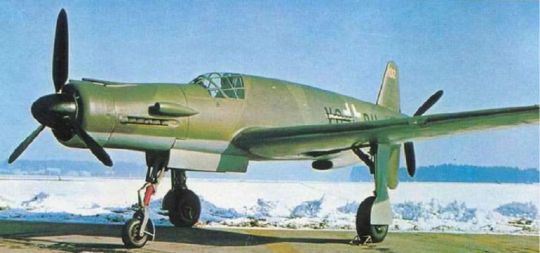
-A Dornier Do 335 Pfeil on a snowy runway, some time in 1944 or '45. | Photo: Luftwaffe
FLIGHTLINE: 181 - DORNIER DO 335 PFEIL ("ARROW")
Initially designed in response to a request for a Schnellbomber, the Do 335 was reconfigured into a multi-role aircraft, though only a few were completed before Germany surrendered.
Claude Dornier founded the Dornier Flugzeugwerke ("Aircraft factory") in 1914, and was renowned for building large, all-metal flying boats as well as land-based passenger aircraft between the Great War and WWII. These included the record-breaking Do 16 Wal ("Whale") of 1924, the Do X of 1929, and the Komet ("Comet") and Merkur ("Mercury"), a favorite of Lufthansa and SCADTA in Colombia, as well as several South American militaries. A feature of many Dornier aircraft were tandem engines, a tractor and a pusher motor placed back to back. This arrangement allowed an aircraft to enjoy the extra power of having multiple engines without the associated drag of having multiple tractor installations. It also alleviated the issue of asymmetric thrust in case of an engine failure.
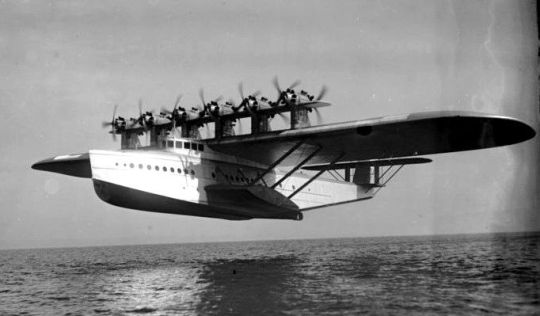
-A Do X in flight, circa January 1932. This was one of a number of Dornier flying boats to have a tandem engine configuration. | Photo: German Federal Archives
DEUTSCHLAND PFEILE
What became the Do 335 originated in 1939, while Dornier was working on the P.59 Schellbomber ("high-speed bomber"), which would have carried and equivalent load to a Ju 88 or Me 410, but featured a tandem engine arrangement. Work on the P.59 was cancelled in 1940, but Dornier had already commissioned a test aircraft, the Göppingen Gö 9, to test the feasibility of connecting a pusher prop via an extended drive shaft. The Go 9 was based on the Do 17 bomber, but scaled down 40% and with a cruciform tail. The test plane validated Dornier's designs, though the eventual fate of the Go 9 is not known (likely though, it was destroyed by Allied bombing or recycled).
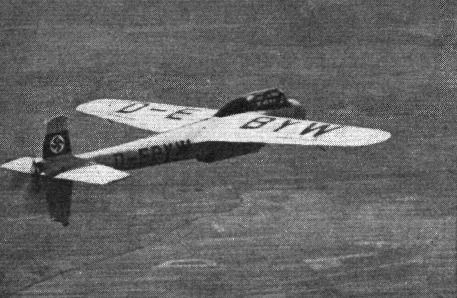
-The Göppingen Gö-9 motor glider, designed by Wolf Hirth. flying c.1941. | Photo: Flightglobal
The P.59's general design was resurrected in 1942 when the RLM requested a high-speed bomber with a 1,000kg payload. Dornier submission, designated the P.231, was awarded a development contract and the model number Do 335. Late in 1942, the requirements were changed from a Schnellbomber to a multirole fighter, which resulted in extensive delays while the designs were updated.
FLUGZEUGSPEZIFIKATIONEN
The Do 335 was 13.85m long, with a wingspan of 13.8m and a height of 5m. Empty, the plane weighed 7,260kg, while at max TO the weight was 9,600kg (10,000kg for the two-seat trainers and night fighter variants). Power was provided by two Daimler-Benz DB 603E-1 liquid-cooled V-12s developing 1,324kW each. Due to the situation in late-war Germany, the engines were fitted to run on 87 octane "B4" lignite-derived synthetic fuel, and MW50 boost was also available for additional speed. The basic fighter/bomber variant was armed with a singe 30mm MK 103 cannon firing through the spinner and two 20mm MG 151/20 autocannon mounted in the front engine cowl and synchronized to fire through the prop disc. A single 500kg bomb could be carried internally, and two pylons on the wings could be fitted with bombs, gun pods or drop tanks, with a total load of 100kg. During flight tests, the Do 335 hit 763kmh with boost (686kmh without), making it the fastest production fighter the Luftwaffe fielded during WWII. Under single-engine operations, the plane could still fly at 563kmh. Service ceiling was 11,400m, and under ideal conditions the plane could climb to 8,000m in 14 minutes 30 seconds. Due to concerns over a pilot striking the dorsal fin or the rear prop (a common concern in pusher designs before ejector seats became common), explosive charges would sever the fin and propeller before the pilot would bail out.
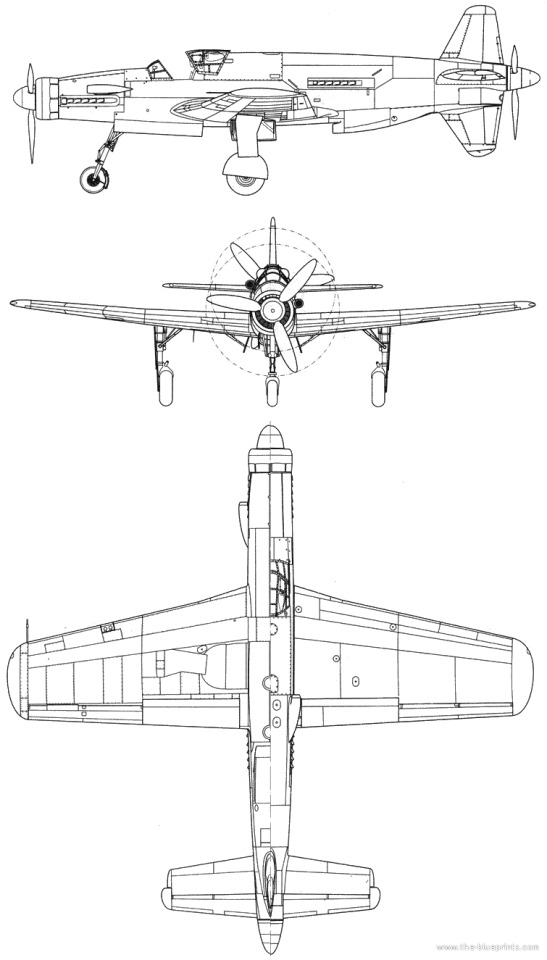
-Orthograph of the Do 335 A-1. | Illustration: Richard Ferriere
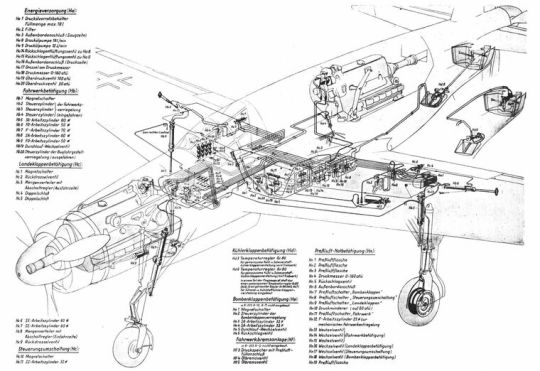
-Cutaway drawing of the Pfeil showing the engines, linkages, and landing gear actuators. | Illustration: Dornier
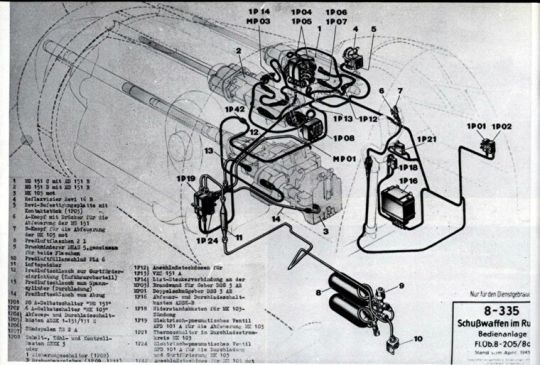
-Mounting locations of the 335's guns and associated equipment. | Illustration: Dornier
Maiden flight of the Do 335 V1 prototype was on 26 October 1943. A total of 27 flights were made with the V1, which uncovered a weakness in the landing gear, and issues with the main landing gear wheel-well doors saw them removed for the majority of the flights. The second aircraft, V2, first flew on 31 December 1943, and featured uprated DB 603A-2 engines as well as aerodynamic changes informed by the V1's test flights as well as wind tunnel tests. Maiden flight of the V3 pre-production aircraft was on 20 January 1944, which was fitted with DB 603G-0 engines, which produced 1,400kW at take off. The V3 was also fitted with two rear-view mirrors, alleviating blind spots caused by the location of the aft engine. A total of ten preproduction aircraft were then ordered, and in January the RLM ordered five more prototypes of the night fighter variant, later designated the A-6. By war's end, at least 16 prototypes of the Do 335 and related programs had flown, accumulating some 60 flight hours.
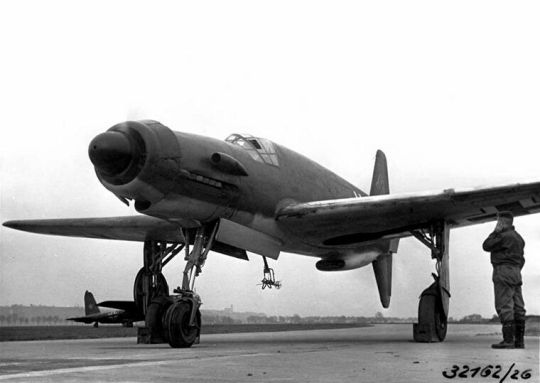
-The Do 335 V1 during testing in 1943 or '44. | Photo: Luftwaffe
Production of the Do 335 was given maximum priority under Hitler's Jägernotprogramm (Emergency Fighter Program), issued on 23 May 1944, and the competing He 219 Uhu ("eagle-owl") Nachtjäger theoretically freed up needed DB 603 engines for the Pfeil, but in practice Heinkel continued production of the 219A. Dornier's factories in Friedrichshafen and Munchen were anticipated to produce 120 and 2,000 Do 335s, of various configurations, by March 1946, but an Allied attack on Friedrichshafen destroyed tooling for the Pfeil, which resulted in a new line being set up in Oberpfaffenhofen. The first preproduction Do 335 A-0 model was delivered in July 1944, and construction of the first production A-1 model began in late 1944. As the war progressed, various models of the Do 335 proliferated (as happened often with late-war aircraft programs) as the Nazis sought to turn back the Allied forces:
Do 335 A-2: single-seat fighter-bomber aircraft with new weapon sights, later proposed longer wing and updated 1,471 kW (1,973 hp) DB603L engines.
Do 335 A-3: single-seat reconnaissance aircraft built from A-1 aircraft, later proposed with longer wing.
Do 335 A-4: single-seat reconnaissance aircraft with smaller cameras than the A-3
Do 335 A-5: single-seat night fighter aircraft, later night and bad weather fighter with enlarged wing and DB603L engines.
Do 335 A-6: two-seat night fighter aircraft, with completely separate second cockpit located above and behind the original.
Do 335 A-7: A-6 with longer wing.
Do 335 A-8: A-4 fitted with longer wing.
Do 335 A-9: A-4 fitted with longer wing, DB603L engines and pressurized cockpit.
Do 335 A-11/12: A-0 refitted with a second cockpit to serve as trainers.
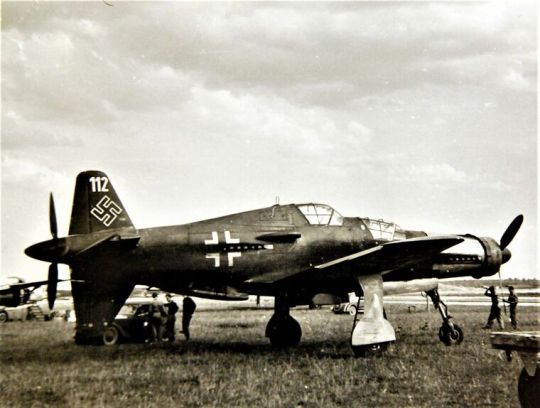
-A Do 335 A-12 trainer, known as the Ameisenbär ("anteater"), late in the war. | Photo: Luftwaffe
Do 335 B-1: abandoned in development.
Do 335 B-2: single-seat destroyer aircraft. Fitted with 2 additional MK 103 in the wings and provision to carry two standard Luftwaffe 300 litre (80 US gal) drop tanks.
Do 335 B-3: updated B-1 but with longer wing.
Do 335 B-4: update of the B-1 with longer wing, DB603L engine.
Do 335 B-6: night fighter.
Do 335 B-12: dual-seat trainer version for the B-series aircraft.
Do 435: a Do 335 with the redesigned, longer wing. Allied intelligence reports from early May 1945 mention spotting a Do 435 at the Dornier factory airfield at Lowenthal.
Do 535: actually the He 535, once the Dornier P254 design was handed over to Heinkel in October 1944; fitted with jet engine in place of rear piston engine.
Do 635: twin-fuselaged long-range reconnaissance version. Also called Junkers Ju 635 or Do 335Z. Mock up only.
P 256: turbojet nightfighter version, with two podded HeS 011 turbojet engines; based on Do 335 airframe.
In April 1945 the Allies captured the Oberpfaffenhofen factory in late April 1945, capturing 11 A-1 fighter/bombers and 2 A-12 trainers. That same month, a flight of four RAF Hawker Tempests, led by French ace Pierre Clostermann, encountered an unknown model of Do 335 over northern Germany at low altitude. The Pfeil pilot began evasive maneuvers, but Clostermann opted to not give chase as the enemy plane displayed superior speed. At the time of the German capitulation in 1945, 22 Do 335A-0, A-1 and A-11/12 aircraft were known to have been completed.
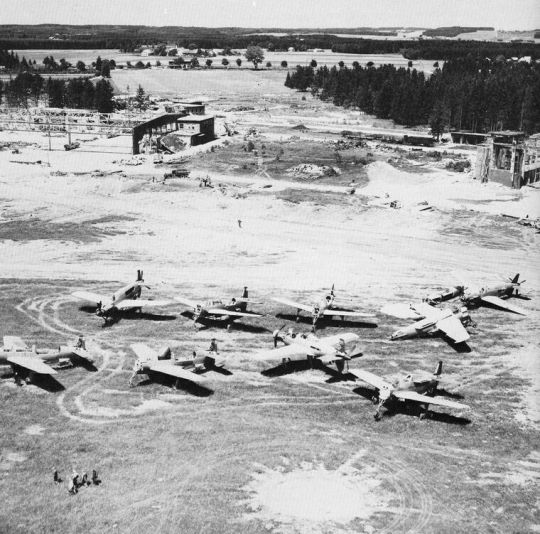
-Dornier Do 335 aircraft on the runway at Oberpfaffenhofen just after the end of the Second World War. | Photo: USAAF
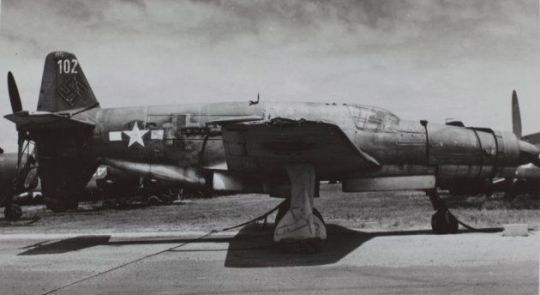
-A Do 335 after being captured by the US, with American markings painted over the Luftwaffe ones. | Photo: Charles Daniels Collection/SDASM Archives
At least two Do 335s were brought to the US under Operation LUSTY, with one, Do 335 A-0, designated A-02, with construction number (Werknummer) 240 102, and Stammkennzeichen ("factory radio code registration") VG+PH being claimed by the Navy for testing. The aircraft was transported on HMS Reaper along with other captured German aircraft, then shipped to the Navy's Test and Evaluation center at NAS Pax River. Another Pfeil was tested by the USAAF at Freeman Field in Indiana, but nothing is known about its fate. In 1961 VG+PH was transferred to the Smithsonian Institution, though it remained outside at NAS Oceana until 1974, when it was shipped back to the Dornier factory in Oberpfaffenhofen for restoration. Over the next year, volunteers from Dornier (some of whom worked on the aircraft originally) found that the explosive charges meant to sever the tail and aft prop were still installed and live, thirty years later. After work was completed the aircraft was placed on display at the Hannover Airshow from 1 to 9 May 1976, and afterwards it was on loan to the Deutsches Museum until 1988. The aircraft was shipped back the States after that, and is now on display at the Udvar-Hazy Center along with other German aircraft brought over during Lusty like the only known Ar 234 Blitz jet bomber and the partially restored He 219A Uhu.
39 notes
·
View notes
Note
That's a lot of talk about the ship's guns but did USS Texas ever get an ice cream machine?
No one ever asks about that. Yes, during World War II she had a soda fountain.

It was located on the 2nd deck and you could get both soda and ice cream there.


Thanks for the ask.
Source, Source
891 notes
·
View notes
Photo

This is probably the world’s most famous newspaper error! President Elect Harry Truman was expected to lose the presidential elections in 1948. Here, he is seen holding a copy of the ‘Tribune’, with its bold headlines – ‘Dewey Defeats Truman’. This image is a grim reminder to journalists, of the importance of verifying information on breaking news stories. The ‘Tribune’ is believed to have adopted an anti-Truman attitude during the elections.
41 notes
·
View notes
Text

Battle of Missionary Ridge, US Civil War, 1863
3 notes
·
View notes